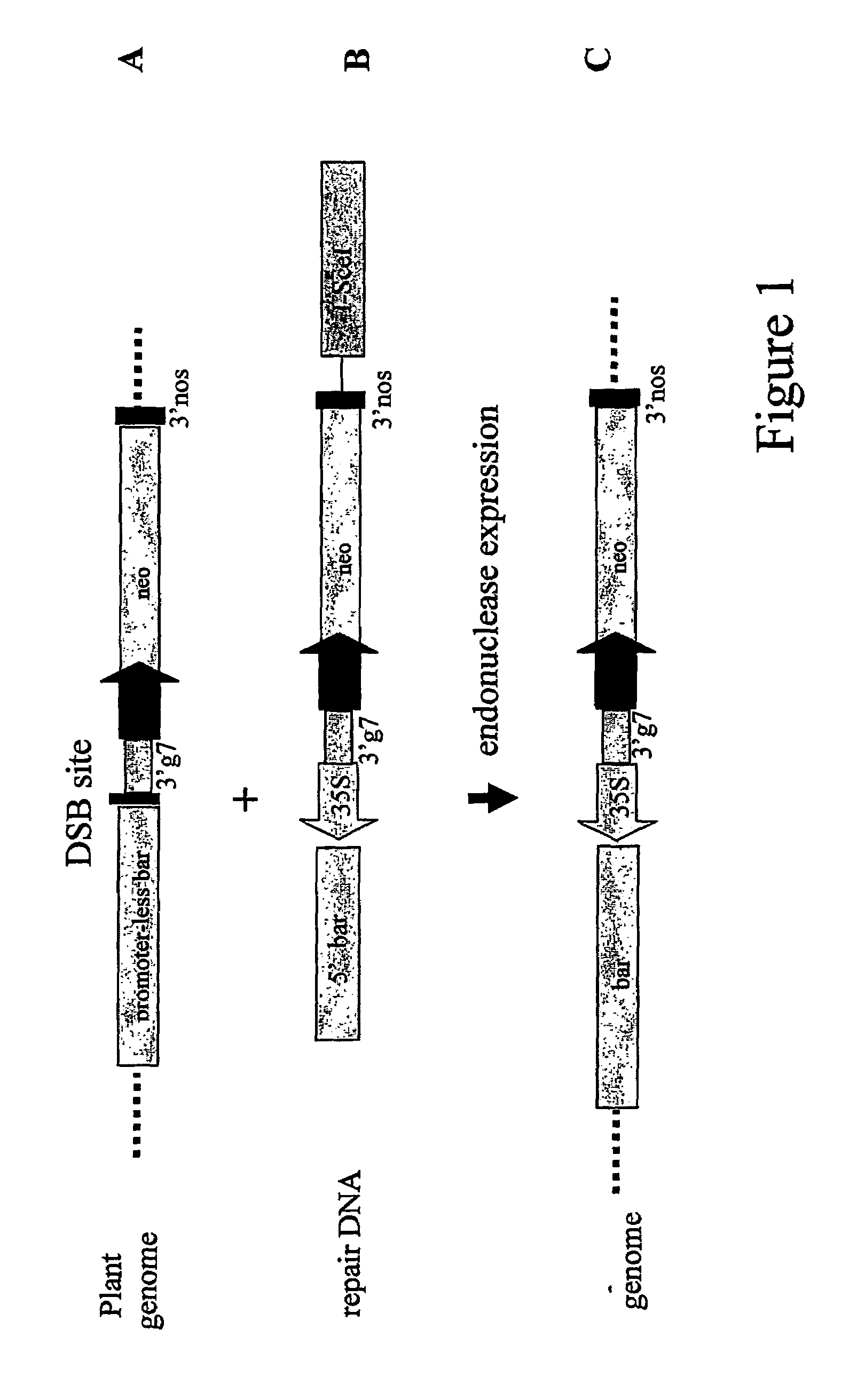Targeted DNA insertion in plants
a plant and dna technology, applied in the field of molecular plant biology, can solve problems such as side effects and unsatisfactory effects
- Summary
- Abstract
- Description
- Claims
- Application Information
AI Technical Summary
Problems solved by technology
Method used
Image
Examples
example i
Design, Synthesis and Analysis of a Plant Expressible Chimeric Gene Encoding I-SceI
[0115]The coding region of I-SceI wherein the 4 aminoterminal amino acids have been replaced by a nuclear localization signal was optimized using the following process:[0116]1. Change the codons to the most preferred codon usage for maize without altering the amino acid sequence of I-SceI protein, using the Synergy Geneoptimizer™;[0117]2. Adjust the sequence to create or eliminate specific restriction sites to exchange the synthetic I-SceI coding region with the universal code I-SceI gene;[0118]3. Eliminate all GC stretches longer than 6 bp and AT stretches longer than 4 bp to avoid formation of secondary RNA structures than can effect pre-mRNA splicing[0119]4. Avoid CG and TA duplets in codon positions 2 and 3;[0120]5. Avoid other regulatory elements such as possible premature polyadenylation signals (GATAAT, TATAAA, AATATA, AATATT, GATAAA, AATGAA, AATAAG, AATAAA, AATAAT, AACCAA, ATATAA, AATCAA, ATAC...
example 2
Isolation of Maize Cell Lines Containing a Promoterless Bar Gene Preceded by an I-SceI Site
[0124]In order to develop an assay for double stranded DNA break induced homology-mediated recombination, maize cell suspensions were isolated that contained a promoterless bar gene preceded by an I-SceI recognition site integrated in the nuclear genome in single copy. Upon double stranded DNA break induction through delivery of an I-SceI endonuclease encoding plant expressible chimeric gene, and co-delivery of repair DNA comprising a CaMV 35S promoter operably linked to the 5′ end of the bar gene, the 35S promoter may be inserted through homology mediated targeted DNA insertion, resulting in a functional bar gene allowing resistance to phosphinothricin (PPT). The assay is schematically represented in FIG. 1.
[0125]The target locus was constructed by operably linking through conventional cloning techniques the following DNA regions[0126]a) a 3′ end termination and polyadenylation signal from th...
example 3
Homology Based Targeted Insertion
[0134]The repair DNA pTTA82 is a T-DNA vector containing between the T-DNA borders the following operably linked DNA regions:[0135]a) a DNA region encoding only the aminoterminal part of the bar gene[0136]b) a DNA region comprising a partial I-SceI recognition site (13 nucleotides located at the 5′ end of the recognition site)[0137]c) a CaMV 35S promoter region[0138]d) a DNA region comprising a partial I-SceI recognition site (9 nucleotides located at the 3′ end of the recognition site)[0139]e) a 3′ end termination and polyadenylation signal from A. tumefaciens gene 7 (3′g7)[0140]f) a chimeric plant expressible neomycine resistance gene[0141]g) a defective I-SceI endonuclease encoding gene under control of a CaMV 35S promoter
[0142]The nucleotide sequence of the T-DNA of pTTA82 is represented in SEQ ID NO 6.
[0143]This repair DNA was co-delivered with pCV78 (see Example 1) by particle bombardment into suspension derived cells which were plated on filte...
PUM
| Property | Measurement | Unit |
|---|---|---|
| distance | aaaaa | aaaaa |
| pressure | aaaaa | aaaaa |
| frequency | aaaaa | aaaaa |
Abstract
Description
Claims
Application Information
 Login to View More
Login to View More - R&D
- Intellectual Property
- Life Sciences
- Materials
- Tech Scout
- Unparalleled Data Quality
- Higher Quality Content
- 60% Fewer Hallucinations
Browse by: Latest US Patents, China's latest patents, Technical Efficacy Thesaurus, Application Domain, Technology Topic, Popular Technical Reports.
© 2025 PatSnap. All rights reserved.Legal|Privacy policy|Modern Slavery Act Transparency Statement|Sitemap|About US| Contact US: help@patsnap.com

